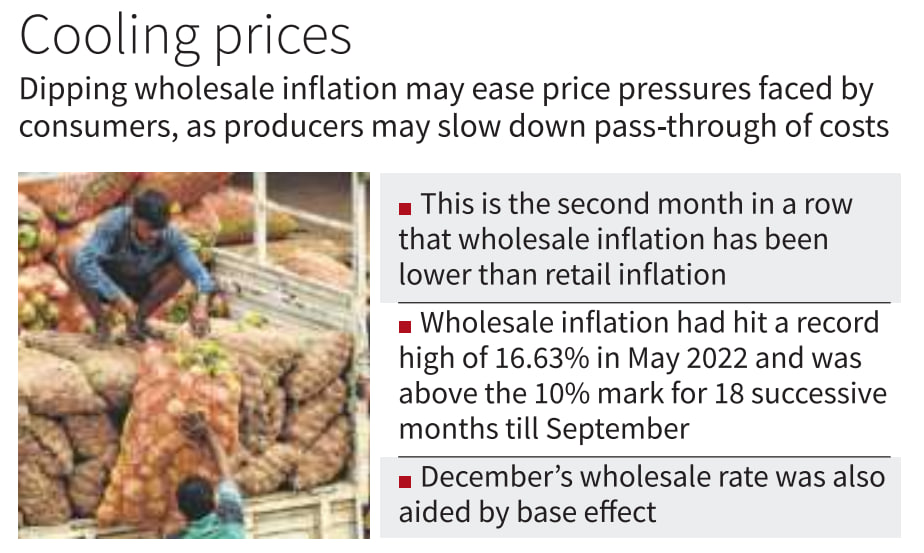Description

Copyright infringement not intended
In News:
- India’s wholesale price inflation declined to 4.95% in December 2022 from 5.85% in November, the number is the lowest in the 22 month.
- This will ease the price rise faced by consumers, as producers may slow down the shifting of input costs at the retail level.
- Fuel and power is the only category to record an increase in price rise from 17.35% in November to 18.1%.
- Food and primary articles declined from 2.2% to 0.65% and 5.5% to 2.4%, respectively.
What is Inflation?
- Inflation refers to a sustained increase in the general price level of goods and services in an economy over a period of time.
- It is the rise in the prices of most goods and services of daily or common use, such as food, clothing, housing, recreation, transport, consumer staples, etc.
- Inflation measures the average price change in a basket of commodities and services over time.
- The opposite and rare fall in the price index of this basket of items is called ‘deflation’.
- Inflation is indicative of the decrease in the purchasing power of a unit of a country’s currency. This is measured in percentage.
.jpeg)
Wholesale Price Index:
- The Wholesale Price Index (WPI) reflects changes in the average prices of goods at the wholesale level — that is, commodities sold in bulk and traded between businesses to other businesses or entities rather than goods bought by consumers.
- Thus, WPI is the price that wholesalers (factories) pay. A rise in the index means that factories have to pay more for raw materials.
Who publishes WPI in India and what does it show?
- WPI is released by the Economic Advisor in the Ministry of Commerce and Industry.
- The index basket of WPI categorises commodities under three groups — primary articles, fuel and power-manufactured products.
- The purpose of WPI is to inspect the movement in prices of goods that reflect supply and demand in industry, construction and manufacturing.
- An upward surge in the WPI indicates inflationary pressure in the economy and vice versa.
- The quantum of rise in the WPI month after month is used to measure the level of wholesale inflation in the economy.
- Base year: 2011-12. (In the calculation of an index the base year is the year with which the values from other years are compared).
- WPI is extensively used for short-term policy intervention as it is the only index that is available on a weekly basis.
Major components of WPI:
- Primary articles are a major component of WPI, further subdivided into Food Articles and Non-Food Articles.
- Food Articles include items such as Cereals, Paddy, Wheat, Pulses, Vegetables, Fruits, Milk, Eggs, Meat & Fish, etc.
- Non-Food Articles include Oil Seeds, Minerals and Crude Petroleum
- The next major basket in WPI is Fuel & Power, which tracks price movements in Petrol, Diesel and LPG
- The biggest basket is Manufactured Goods. It spans a variety of manufactured products such as Textiles, Apparel, Paper, Chemicals, Plastic, Cement, Metals, and more.
- The manufactured Goods basket also includes manufactured food products such as Sugar, Tobacco Products, Vegetable and Animal Oils, and Fats.

Limitations of WPI:
- There are certain limitations in using WPI as a measure for inflation, as WPI does not consider the price of services, and it does not reflect the consumer price situation in the country.
- Thus, WPI is used as a key measure of inflation in some economies; but RBI no longer uses it for policy purposes, including setting repo rates.
- RBI currently uses CPI or retail inflation as a key measure of inflation to set the monetary and credit policy.
What are the implications of WPI for the economy, industry, investors and consumers?
- WPI hits the productive sector: factories mostly. It has on equity investors in the sense margins of companies take a hit when they don’t pass on high raw material prices to consumers. WPI has a delayed impact on consumers if it persists.
How can the government control high WPI?
- Government can control the WPI only through taxes: customs duties and GST.
- In the event of a steep rise in crude oil GOI can cut excise on fuels. But there is a limit to which governments can cut taxes. They too have salaries to pay.
WPI and its Significance
- WPI helps in measuring the macroeconomic and microeconomic conditions of the economy.
- WPI provides estimates of inflation at the wholesale transaction level for the economy overall. It also helps in timely intervention by the government to monitor inflation before the price hike spills over to retail prices.
- WPI-based inflation is used by the government in preparation for fiscal, trade, and other economic policies.
- Business organizations, policymakers, accountants, and statisticians use WPI as an indexing tool to formulate price adjustment clauses.
- The rise in WPI indicates inflationary pressure in the economy, and vice versa. The extent of the rise in WPI is used to measure the level of wholesale inflation in the economy.

https://epaper.thehindu.com/Home/ShareArticle?OrgId=G37AOQ834.1&imageview=0












